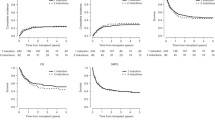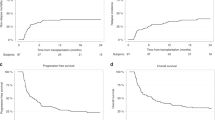Abstract
Double umbilical cord blood transplantation (dUCBT), developed as a strategy to treat large number of patients with hematologic malignancies, frequently leads to the long-term establishment of a new hematopoietic system maintained by cells derived from a single umbilical cord blood unit. However, predicting which unit will predominate has remained elusive. This retrospective study examined the risk factor associated with unit predominance in 262 patients with hematologic malignancies who underwent dUCBT with subsequent hematopoietic recovery and complete chimerism between 2001 and 2009. Dual chimerism was detected at day 21–28, with subsequent single chimerism in 97% of the cases by day +100 and beyond. Risk factors included nucleated cell dose, CD34+ and CD3+ cell dose, colony-forming units-granulocyte macrophage dose, donor–recipient HLA match, sex and ABO match, order of infusion and cell viability. In the myeloablative setting, CD3+ cell dose was the only factor associated with unit predominance (odds ratio (OR) 4.4, 95% confidence interval (CI) 1.8–10.6; P<0.01), but in the non-myeloablative setting, CD3+ cell dose (OR 2.1, 95%CI 1.0–4.2; P=0.05) and HLA match (OR 3.4, 95%CI 1.0–11.4; P=0.05) were independent factors associated with unit predominance. Taken together, these findings suggest that immune reactivity has a role in unit predominance, and should be considered during graft selection and graft manipulation.
This is a preview of subscription content, access via your institution
Access options
Subscribe to this journal
Receive 12 print issues and online access
$259.00 per year
only $21.58 per issue
Buy this article
- Purchase on Springer Link
- Instant access to full article PDF
Prices may be subject to local taxes which are calculated during checkout


Similar content being viewed by others
References
Barker JN, Weisdorf DJ, DeFor TE, Blazar BR, McGlave PB, Miller JS et al. Transplantation of 2 partially HLA-matched umbilical cord blood units to enhance engraftment in adults with hematologic malignancy. Blood 2005; 105: 1343–1347.
Brunstein CG, Barker JN, Weisdorf DJ, Defor TE, McKenna D, Chong SY et al. Intra-BM injection to enhance engraftment after myeloablative umbilical cord blood transplantation with two partially HLA-matched units. Bone Marrow Transplant 2009; 43: 935–940.
Delaney C, Heimfeld S, Brashem-Stein C, Voorhies H, Manger RL, Bernstein ID . Notch-mediated expansion of human cord blood progenitor cells capable of rapid myeloid reconstitution. Nat Med 2010; 16: 232–236.
De Lima M, Robinson S, McMannis J, Alousi AM, Saliba RM, Munsell M et al. Mesenchymal stem cell based cord blood expansion leads to rapid engraftment of platelets and neutrophils. Blood 2010; 116: 164.
Ballen KK, Spitzer TR, Yeap BY, McAfee S, Dey BR, Attar E et al. Double unrelated reduced-intensity umbilical cord blood transplantation in adults. Biol Blood Marrow Transplant 2007; 13: 82–89.
Brunstein CG, Barker JN, Weisdorf DJ, DeFor TE, Miller JS, Blazar BR et al. Umbilical cord blood transplantation after nonmyeloablative conditioning: impact on transplantation outcomes in 110 adults with hematologic disease. Blood 2007; 110: 3064–3070.
Barker JN, Weisdorf DJ, DeFor TE, Blazar BR, Miller JS, Wagner JE . Rapid and complete donor chimerism in adult recipients of unrelated donor umbilical cord blood transplantation after reduced-intensity conditioning. Blood 2003; 102: 1915–1919.
Schichman SA, Suess P, Vertino AM, Gray PS . Comparison of short tandem repeat and variable number tandem repeat genetic markers for quantitative determination of allogeneic bone marrow transplant engraftment. Bone Marrow Transplant 2002; 29: 243–248.
Kristt D, Stein J, Yaniv I, Klein T . Assessing quantitative chimerism longitudinally: technical considerations, clinical applications and routine feasibility. Bone Marrow Transplant 2007; 39: 255–268.
Snedecor G, Cochran W . Statistical Methods, 8th edn. Iowa State University Press: Ames, IA, USA, 1989.
Avery S, Shi W, Lubin M, Gonzales AM, Heller G, Castro-Malaspina H et al. Influence of infused cell dose and HLA-match on engraftment after double-unit cord blood allografts. Blood 2011; 117: 3277–3285.
Gutman JA, Turtle CJ, Manley TJ, Heimfeld S, Bernstein ID, Riddell SR et al. Single-unit dominance after double-unit umbilical cord blood transplantation coincides with a specific CD8+ T-cell response against the nonengrafted unit. Blood 2010; 115: 757–765.
Haspel RL, Kao G, Yeap BY, Cutler C, Soiffer RJ, Alyea EP et al. Preinfusion variables predict the predominant unit in the setting of reduced-intensity double cord blood transplantation. Bone Marrow Transplant 2008; 41: 523–529.
Kanda J, Rizzieri DA, Gasparetto C, Long GD, Chute JP, Sullivan KM et al. Adult dual umbilical cord blood transplantation using myeloablative total body irradiation (1350cGy) and fludarabine conditioning. Biol Blood Marrow Transplant 2011; 17: 867–874.
Scaradavou A, Smith KM, Hawke R, Schaible A, Abboud M, Kernan NA et al. Cord blood units with low CD34+ cell viability have a low probability of engraftment after double unit transplantation. Biol Blood Marrow Transplant 2010; 16: 500–508.
Ho VT, Soiffer RJ . The history and future of T-cell depletion as graft-versus-host disease prophylaxis for allogeneic hematopoietic stem cell transplantation. Blood 2001; 98: 3192–3204.
Marmont AM, Horowitz MM, Gale RP, Sobocinski K, Ash RC, van Bekkum DW et al. T-cell depletion of HLA-identical transplants in leukemia. Blood 1991; 78: 2120–2130.
Eldjerou LK, Chaudhury S, Baisre-de Leon A, He M, Arcila ME, Heller G et al. An in vivo model of double-unit cord blood transplantation that correlates with clinical engraftment. Blood 2010; 116: 3999–4006.
Ratajczak MZ, Reca R, Wysoczynski M, Yan J, Ratajczak J . Modulation of the SDF-1-CXCR4 axis by the third complement component (C3)–implications for trafficking of CXCR4+ stem cells. Exp Hematol 2006; 34: 986–995.
Hoggatt J, Singh P, Sampath J, Pelus LM . Prostaglandin E2 enhances hematopoietic stem cell homing, survival, and proliferation. Blood 2009; 113: 5444–5455.
Acknowledgements
We thank Michael J Franklin (The University of Minnesota) for editing the manuscript. This work was supported in part by grants from the National Cancer Institute CA65493 (CGB, TED, BRB, JSM, PBM and JEW) and CA77598 (TED), Children's Cancer Research Fund (JEW, TED and MRV), Universidad Católica de Chile (PR), American Cancer Society Audrey Meyer Mars International Fellowship in Clinical Oncology (PR), American Society of Blood and Marrow Transplantation Robert A. Good New Investigator Award (CGB), and the Leukemia and Lymphoma Society Scholar in Clinical Research Award (CGB).
Authors contributions: Pablo Ramirez was involved in the study conception, data collection and analysis, and draft and final approval of the version to be published. John E Wagner and Claudio G Brunstein were involved in the study conception, design, data analysis, review and final approval of the version to be published. Todd E DeFor was involved in the data analysis and review, and final approval of the version to be published. Bruce R. Blazar and Philip B McGlave were involved in the study conception and in the review and final approval of the version to be published. Michael R Verneris, David H McKenna and Daniel J Weisdorf were involved in the review and final approval of the version to be published. Jeffrey S Miller was involved in the study conception and in the review and final approval of the version to be published.
Author information
Authors and Affiliations
Corresponding author
Ethics declarations
Competing interests
The authors declare no conflict of interest.
Rights and permissions
About this article
Cite this article
Ramirez, P., Wagner, J., DeFor, T. et al. Factors predicting single-unit predominance after double umbilical cord blood transplantation. Bone Marrow Transplant 47, 799–803 (2012). https://doi.org/10.1038/bmt.2011.184
Received:
Accepted:
Published:
Issue Date:
DOI: https://doi.org/10.1038/bmt.2011.184
Keywords
This article is cited by
-
Chimerism analysis for clinicians: a review of the literature and worldwide practices
Bone Marrow Transplantation (2022)
-
Engraftment kinetics after transplantation of double unit cord blood grafts combined with haplo-identical CD34+ cells without antithymocyte globulin
Leukemia (2021)
-
Cord blood research, banking, and transplantation: achievements, challenges, and perspectives
Bone Marrow Transplantation (2020)
-
New sources for argument: do HLA-C and HLA disparity in adult double umbilical cord blood transplants predict outcomes?
Bone Marrow Transplantation (2016)
-
Advances in umbilical cord blood manipulation—from niche to bedside
Nature Reviews Clinical Oncology (2015)



